We live in the golden age of information. From social media to blog articles, we can now share our knowledge and learn from others like never before. But while social media may work well for short tidbits of information, it isn’t the best medium for exploring topics in depth. Enter online courses.
eLearning courses aren’t only excellent tools for delving into a topic. They’re also a fantastic way to build community, grow your business, and monetize your expertise. And to create engaging courses that hit the mark, you’ll eventually need to invest in online course builders.
My guide rounds up six of the best online course builders that money can buy, including the pros and cons of each tool.
- What Is an Online Course Builder?
- Must-have Features for Online Course Creators
- The 6 Best Online Course Builders
- Final Thoughts
What Is an Online Course Builder?
An online course builder is software used to create eLearning training. These tools allow anyone to create interactive training courses without coding experience or advanced tech skills.
The leading online course platforms offer white labeling, customizable templates, and character libraries, allowing you to design professional-grade learning experiences. Moreover, you can easily export your finished product in the correct format (such as SCORM). That means you can share your online course across multiple learning platforms.
Must-have Features for Online Course Creators
There’s much to consider when choosing an eLearning course builder, especially if you’re not a seasoned instructional designer. So, to help you choose the best online course builder for your needs, I’ve compiled a kind of feature wish list. Here’s what a decent online course builder should have:
- Support for multiple content formats (audio, video, PDF, images, etc.)
- Rich customization and branding options
- Interactive assessment features
- eCommerce integrations
- Intuitive interface
- Reporting and analytics to measure training impact
- Custom templates to speed up online course creation
With these core features, you’ll have everything you need to build exceptional online courses and monitor their performance.
The 6 Best Online Course Builders
These are the six “best-in-class” tools for creating impactful eLearning courses, provided with their pros and cons. Whether you’re an L&D professional looking for a new online course builder or an individual wanting to monetize your knowledge, this shortlist will help you make an informed decision.
| Online Course Builder | Core Features | Pricing |
| Thinkific | – Custom HTML and CSS – Extensive integrations – Lead generation tools – Community building features | – Free Forever – Basic: $49/month – Start: $99/month – Grow: $199/month |
| LearnWorlds | – White-labeling – Marketing tools – Mobile app (for an extra fee) – Support for live classes | – Free 30-day trial – Starter: $29/month – Pro Trainer: $99/month – Learning Center: $299/month – Corporate: Upon request |
| iSpring Suite | – Zero learning curve – Video editing studio – Real-time assessments – Mobile learning | – Free 14-day trial – iSpring Suite: $770/year – Max: $970/year – Premium: $1,970/year |
| Teachable | – Marketing tools – Cloud-based content library – Weighted assignments – Multiple instructor accounts | – Free Forever – Basic: $39/month – Pro: $199/month – Advanced: Upon request |
| LearnDash | – Customizable, open-source platform – Drip-feed feature – Third-party software add-ons – Different pricing plans | – Basic: $159/year – Plus: $189/year – Pro: $329/year |
| Mighty Networks | – Native live streaming – Community feeds and private chats – Branded app (with the Mighty Pro plan) – Customizable community spaces | – Free 14-day trial – Community: $39/month – Business: $119/month – Mighty Pro: Upon request |
1. Thinkific
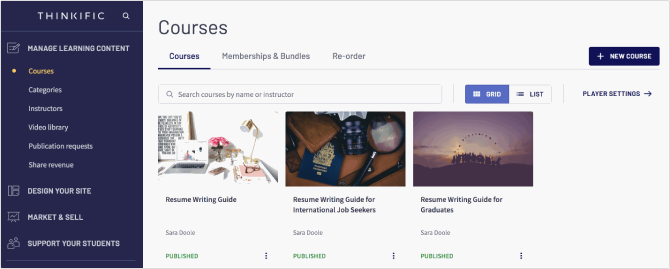
Description
Thinkific is a web-based online course builder with excellent customization options. You can easily add your branding to courses, personalize how learners access content, and tailor payment gateways. There are also some nice features for streamlining online course creation, such as bulk content importing and automated completion certificates.
The platform is relatively straightforward to navigate, making it an ideal choice for novices. It has a simple drag-and-drop course builder, so you can easily add and arrange elements on the page.
What’s more, it comes with a range of customizable templates for both course content and landing pages. This means you can build tailored flagship and pre-sell courses without previous design experience. The option to develop a resource library for paying members is a nice touch too.
Also, Thinkific provides some excellent social learning tools, including student discussion boards and feedback channels. Finally, there’s a decent selection of assignment, quiz, and survey options to engage learners, gather course feedback, and check progress.
Pros
Thinkific offers many great features that empower users to up their online course creation game. Some of the highlights include:
- Customizable templates and ready-made course materials
- 1,000+ integrations with a range of popular tools
- Testimonials feature: lets you add learner reviews (of your choice) directly to your landing page
- Built-in social sharing options
- Lead generation tools (builders for landing pages, pop-up forms, and online forms)
- Completion certificates
Cons
This platform has a few areas that need improvement. Here’s where Thinkific falls short:
- Does not support SCORM, Tin Can, or AICC files/reporting
- The dashboard needs an update
- The media library lacks high-quality images
- Advanced reporting is only available with the higher priced plans
- Some key features like assignments and live lessons aren’t included in the Basic plan
2. LearnWorlds
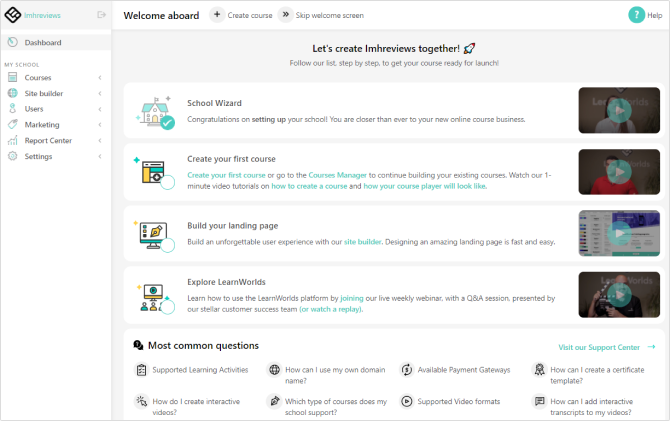
Description
LearnWorlds is a robust online course builder available online and as an app. It’s simple to use, allowing you to build a range of learning materials. This includes blogs and interactive eBooks. Pre-built templates also speed up creation time and help create a cohesive learning experience.
We particularly like the rich content editing tools, which allow for full-blown customization of courses. The platform also has some cool engagement features, including learner discussion forums. This is great for community building and interacting with your audience directly.
Lead generation features like pop-up windows, learning pages, and integrated payment gateways make it easy to market your courses.
LearnWorlds supports SCORM and HTML, which allows you to share your eLearning modules across multiple learning platforms and websites. Finally, you can easily configure the settings to deliver a tailored learner experience by creating sections with access for paying members only, for instance. Then, the data analytics allows you to segment these user sections for a clear performance overview.
Pros
Here are some of the most notable features of this tool:
- Pre-built templates
- Social learning tools
- Marketing features, including NPS scores, promotions, and affiliate management
- Advanced data analytics
- Supports SCORM and HTML
- Options for white labeling (for an extra fee)
- Custom iOS/Android App (for an extra fee)
Cons
Despite some strong, learner-centric features, LearnWorlds has some room for improvement in the following areas:
- Lacks features for community building
- No options for hosting live events
- Some key features (like platform branding) are only available with higher price plans
- The Starter Plan offers limited integrations with other tools
- No marketplace or marketing support
3. iSpring Suite
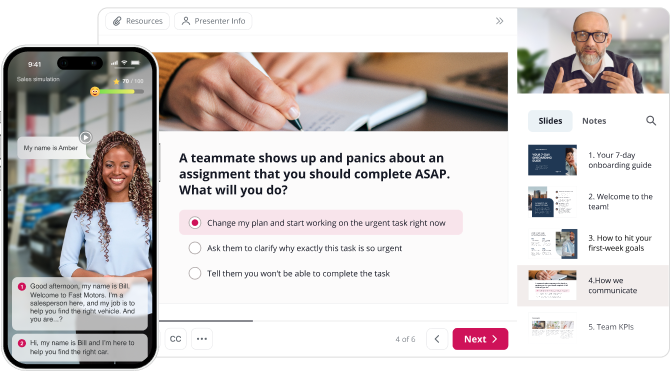
Description
iSpring Suite is an award-winning eLearning course builder with rich functionality. It’s a PowerPoint-based format, meaning you can build courses without any design experience or coding skills. In addition, you can brand your courses entirely and customize the learner experience.
iSpring offers a fully stocked library of templates, characters, and images to build industry-specific online courses and match various audiences. These are excellent for storytelling and utilizing scenario-based learning.
Speaking of which, the course builder covers every training scenario you can imagine. For instance, you can create role-plays, video lectures, interactive practice activities, narration, slides, and quizzes. All of this enables you to engage learners on a whole new level. In addition, it has a fully equipped video editing studio for recording screencasts and video lectures, as well as adding captions or other interactive elements to your videos.
iSpring Suite supports SCORM, HTML5, and xAPI formats, making it easy to share online courses across multiple platforms. Plus, you can take advantage of SCORM reporting, which gives you access to comprehensive learning data.
The iSpring Suite online course builder also integrates with iSpring Learn LMS, so you can upload courses to the platform instantly and sell them through the Shopify integration.
iSpring Suite also comes with an online collaboration tool, iSpring Space, a cloud-based service that enables you to build, co-edit, and share micro-courses in your browser. It’s perfect for speeding up content creation, creating preboarding training materials, microlearning, or follow-up content.
Pros
Here’s where iSpring Suite excels:
- Supports SCORM, xAPI, and other eLearning formats
- Fast content exporting options
- Extensive content library
- 24/7 customer support
- Cloud sharing and collaboration in iSpring Page
- Multi-lingual support
Cons
This is one of the best online course builders on the market, but there are still some areas for improvement. iSpring could improve in the following areas:
- No lead generation features
- Windows-only
- No built-in marketing tools
4. Teachable

Description
Teachable is an intuitive platform for building brand websites and sales pages. There’s a range of templates, meaning you can create your pages without coding experience. This also saves time during the creation process.
With Teachable, you can create flexible pricing, subscription plans, coupons, and bundles for your courses. Extensive customization features allow you to create branded themes, custom URL domains, and payment gateways. Moreover, the feedback tools make it easy to gauge how your content is being received.
Teachable has solid analytics, which offers a comprehensive overview of course performance and areas to improve. In addition, the Pro Plan offers some interesting affiliate marketing tools, and I like the email marketing feature too. These added extras allow you to build your community and grow your business.
Finally, Teachable integrates with a number of popular tools, so you can easily incorporate it into your existing tech stack.
Pros
Here are some of Teachable’s most notable features and functionalities:
- Intuitive interface
- Extensive integrations
- Template library
- Marketing tools (available with higher price plans)
- Responsive customer support
Cons
Teachable has some work to do in the following areas:
- Doesn’t support SCORM or HTML5
- Limited community-building features
- No white labeling or branded app
- Users can only make payments through PayPal or Teachable
- Page builder has limited customization options
- 30-day payout delay on the Basic Plan
5. LearnDash
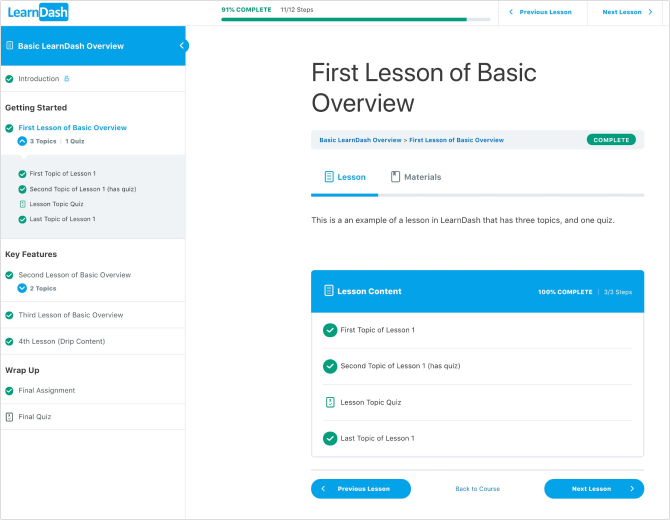
Description
LearnDash is an LMS plug-in built for WordPress. Thanks to its intuitive interface and comprehensive eCommerce functionality, it’s one of the top online course builders.
Authors can easily create free or paid online courses with the simple drag-and-drop builder. Plus, the gamification tools allow you to motivate learners with badges and points.
Since it’s an open-source platform, you can tweak the code and fully customize the platform. In addition, you can automate many workflows and gain access to important learner metrics.
LearnDash integrates with an extensive array of popular third-party tools, allowing you to improve its functionality. For example, it integrates with popular payment gateways like PayPal and Square. And naturally, it’s easy to deploy on WordPress.
As a self-hosted LMS, the platform gives you full control over the learner experience on your site. On the other hand, it requires you to do all the heavy lifting to set it up. This may not be feasible for some businesses or course creators.
Pros
LearnDash shines in the following areas:
- Ease of use
- Active community for sharing tips and tricks
- Large integration list for increased functionality
- Advanced reporting and analytics
- Extremely customizable
- Gamification features
Cons
The platform could use a little more work in these areas:
- Requires a working knowledge of WordPress
- Steeper learning curve compared to other options on this list
- No integrated marketing features
- Requires additional add-ons to unlock its full functionality
- Trickier initial setup as a self-hosted LMS
- Limited user role management and learning pathways
- No free trial
6. Mighty Networks
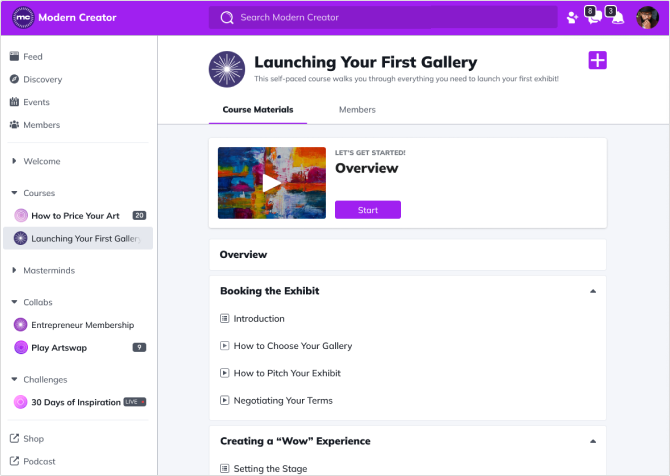
Description
Mighty Networks is, first and foremost, a community-building tool that comes with a course builder. As such, users can create and manage online courses while growing their communities.
You can sell individual courses, community memberships, or bespoke bundles. Moreover, users can a make one-time payment or sign up for a subscription.
I especially like the engagement tools, such as the real-time activity feed. Instructors can also create polls and set up topics to encourage community discussions. Plus, learners can share their own content to boost interaction and participation.
Mighty Networks is an excellent option if you plan to run regular live streams or virtual events, and you can quickly build resource libraries to educate your audience. It also offers features that allow you to automate workflows and help manage your community, including automated invitations. It also integrates with a good range of third-party tools.
Last but not least, the analytics are fairly detailed, giving you access to member activity, engagement, and course completion rates.
Pros
Some of the biggest pros include:
- Robust engagement features, such as activity feeds and polls
- Support for live streams and virtual events
- Student welcome checklist to onboard learners
- Learner chat function
- Paid groups and live events to build community
- Resource libraries
Cons
Here are some of the cons:
- Lacks customization and branding options
- Interface could be more intuitive
- Limited lead generation features
- The course builder is only available with higher priced plans
- Transaction fees on all sales
- Limited customer service
- Not ideal for individuals or small brands looking to sell online courses
Final Thoughts
I hope you found this rundown of the six best online course builders helpful. Each solution enables you to create and sell engaging eLearning courses to your audience.
When picking the most appropriate software, consider your needs, goals, skill level, and the must-have features mentioned in this guide. Combined, these factors will help you choose the best tool for the job.







